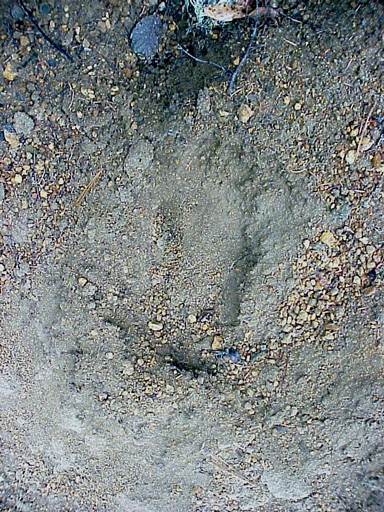Part II… Bigfoot Tracks
Posted by: Rick Noll on October 1st, 2005
1. Bigfoot tracks in the ground or in snow.
Tracks, as John Green stated many times, represent the object that made it, but it isn’t the object that made it. We are not studying the foot of Bigfoot. We are trying to study Bigfoot tracks.
Bigfoot tracks basically look like unshod human tracks. They have a rounded heel area, a rather wide ball and up to five toes (sometimes six have been seen as well as down to just three) but they seem to lack a high arch. Some have concluded that the tracks can sometimes show dermal ridges, like all primates have on their feet and hands. Finger and palm prints are dermal ridges. Other featured difference may also include a mid-tarsal break, whereby the foot of Bigfoot is not as ridged as in human’s and may actually be able to grasp things more like that of apes feet. These tracks are usually embedded very deeply into the ground. They seem to be lined up toe to heel much straighter than with human track ways and the distance between sequential tracks is phenomenally long, longer than what most believe humanly possible.

Sometimes feet are not the only thing that make an impression with these beasts. There have been hands, knees, buttocks and a whole lower torso seen imbedded into the ground.
Every person who looks for Bigfoot, and yes there are quite a few out there, has their own criteria in validating an impression as having come from a Bigfoot. Some hold this information close to the vest because they fear that with this information they might be subject to the ever clever human hoaxer wanting to get their fun at the expense of others.
Dr. Grover Krantz came up with his own list he used to validate a Bigfoot track/cast. But publicly he took this information to his grave (although he did share items on his list with those he trusted).
So, the first thing I do is try and eliminate any type of human origin to a track or track way, whether it be from a hoax, common substrate material displacement from natural objects like rocks, distortion or just an ordinary human track misunderstood. To rule out a hoaxed track I look for tool marks in the track indicating that it was manufactured and not representative of a real living object. I have found digging marks used with what looks like a spoon type of instrument before. I have also found the surrounding soil to be a different grade or that there is impact cracks versus weight cracks, all indicating them more likely a hoax. I have seen what look like tracks coming out of streams along the banks only to determine them to be gross water flow marks. I look for objects nearby that could have been the male object making the female impression. I look for other subset impressions sharing common features. I look for common characteristics between subsequent tracks that have slight miss-registration between them. But the hardest one to work around is determining it not to be just a common house hold human track.
The largest object on a human body being given live birth is usually the head, not the feet. So just where are all the little feet of the juvenile Bigfoot? Surely they are not born with size 22 feet. Well if we take out the most striking difference between human and Bigfoot feet, which is their length, we can get a clue. They just look like infant and adult human tracks. But how can we possibly differentiate the two?
I have a partner in all of this, Owen Caddy. He has worked with wild chimps in Africa and is currently a supervising park ranger here in Washington. He has had a long standing interest in the subject after witnessing something he could not easily explain in his youth. While living in Minnesota he solo camped quite a bit and one night observed a pair of hairy legs walk by his tent, going from one berry bush to another.
Generally speaking, this is our current mentality concerning tracks, although much more can be said then what I have written here, it is not the exact place I want to purpose further thought or methodology.
About Rick Noll
Rick Noll has been actively searching for the Sasquatch since 1969 and continues his pursuit with extended field trips into the Pacific Northwest's most remote regions. Rick has worked with Peter Byrne, René Dahinden, Grover Krantz, John Green, Jeff Meldrum and the BFRO during all this. He helped with many documentaries on the subject including Animal X: The Skookum Expedition and Sasquatch: Legend Meets Science.









